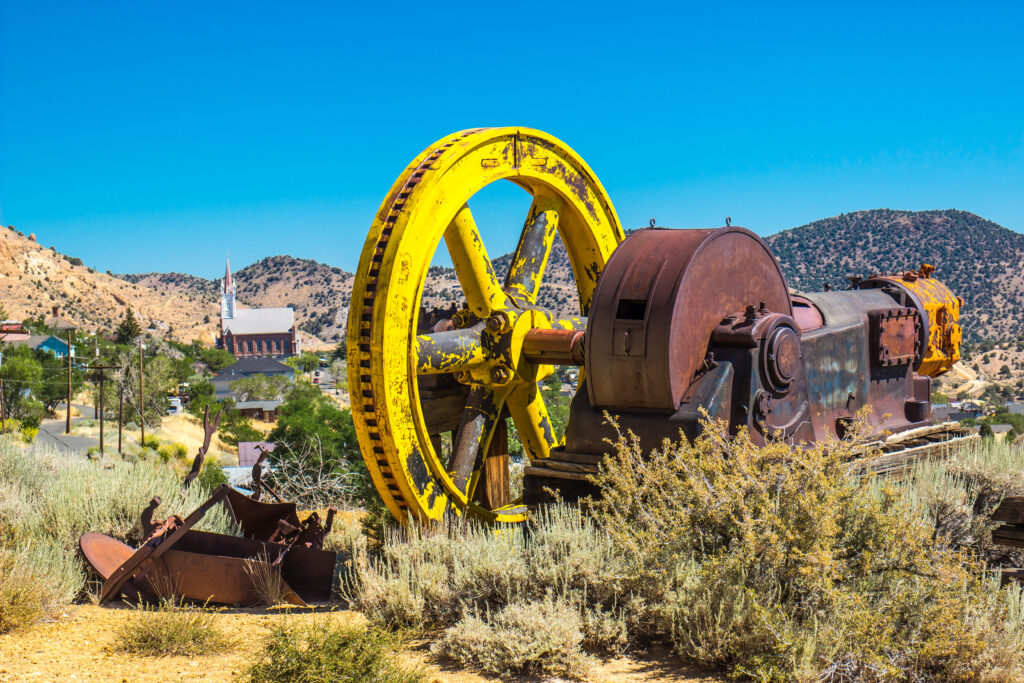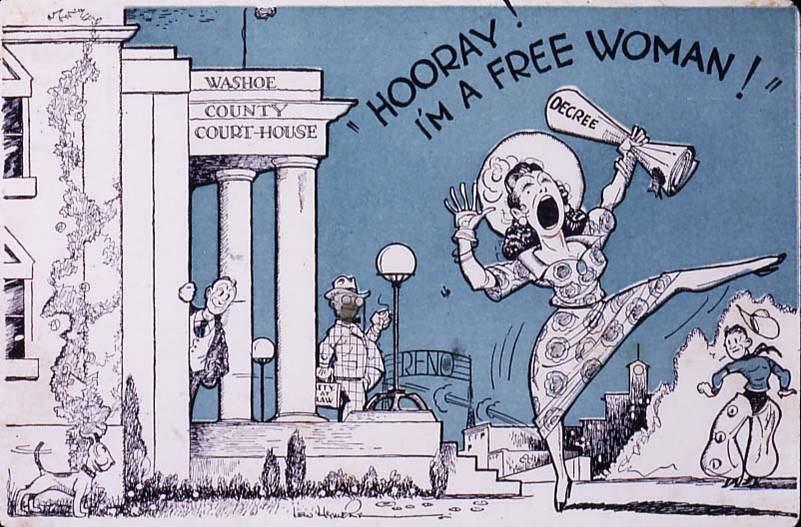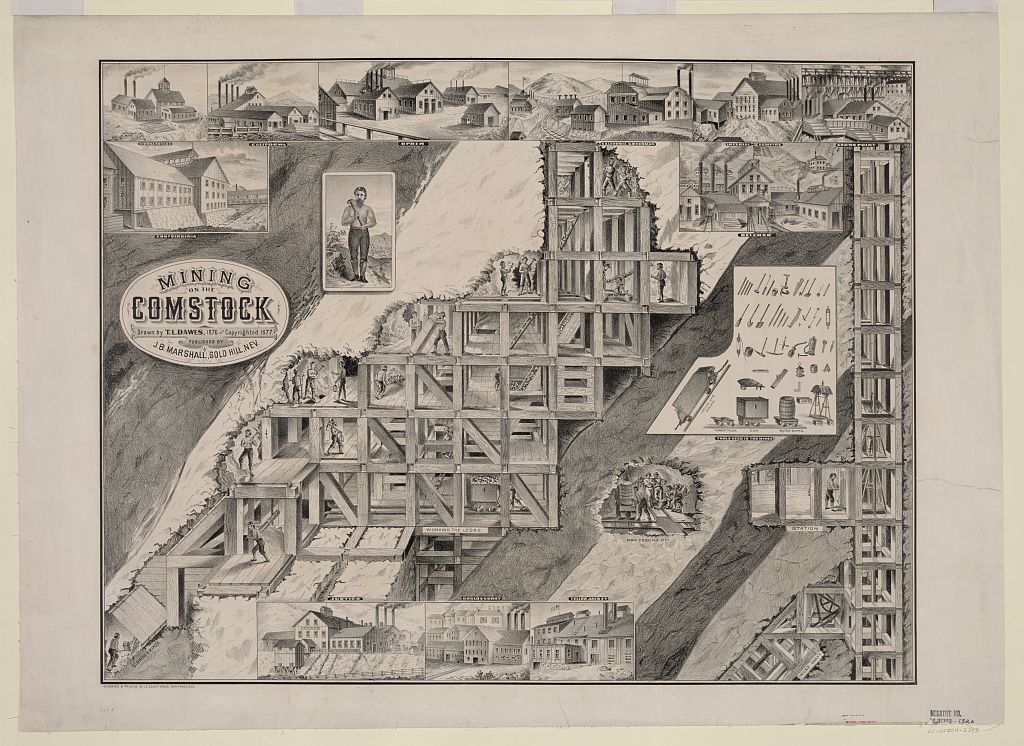Did you know that, despite California’s moniker as the ‘Golden State,’ Nevada outshone its western neighbor in gold production during the famed 19th-century gold rush?
In fact, so much gold and silver was pulled from the mines of Northern Nevada, the most famous being the Comstock Lode of Virginia City, that it forever altered the global silver market.
Nevada’s ascent on the global stage began in June of 1859 when the first silver and gold discovery, known as the Comstock Lode, named for miner Henry Comstock, occurred in the hills of western Nevada. On the spot, the town of Virginia City was built almost overnight, along with Silver City and Gold Hill just down the hill. The discovery was the largest in the world following the California Gold Rush discovery ten years prior.
Many miners who had been drawn west by the California Gold Rush made the trek back across the Sierra to stake their claims in the Virginia City Hills. The lode led to immense fortunes and significant advancements in mining technology in a relatively short period of time.
The Comstock Lode was instrumental in shaping the San Francisco Bay Area; prior to the influx of wealth from the Comstock Lode, San Francisco was little more than a fishing port. The newfound riches from what would later become known as the Silver State prompted significant investments in infrastructure, housing, and various industries. These investments not only supported the mining industry but also catered to the influx of newcomers seeking their fortunes.

Almost overnight, the Comstock Lode created millionaires who, by today’s standards, would be considered multi-billionaires. John William Mackay, one of the “Bonanza Kings,” struck it big by discovering a vein that would be worth $63 million in today’s currency. Just a few short years later, he and the other three Bonanza Kings struck again with a payout exceeding $181 billion in today’s dollars.
One of the most famous miners, whose family is still renowned in the Bay Area for its architectural legacy, is George Hearst. He headed west, like many others, to claim his share of the fortune, including an interest in the Comstock Lode. Hearst invested millions in California, acquiring tens of thousands of acres for ranches and homesites. However, it was his son, William Randolph Hearst, who went on to build the colossal mansion known as Hearst Castle. It took 28 years to construct, and was inspired by the European castles he had frequently visited. Though the castle wasn’t finished before Hearst’s passing, it remains open to the public and leaves an indelible legacy traceable to the mines of Virginia City.
Beginning of boom and bust
Another boom industry came to the Silver State soon after the Comstock Lode: the Divorce Industry.
Reno, known as Nevada’s Biggest Little City, was built from the riches of the Virginia City mines like many of the region’s towns, but it gained a unique identity as it pioneered the “quickie divorce” business, which was at the time a brand-new industry.
The mines began to decline around 1880, with some mining continuing through 1918, when the last of them finally closed their shafts for good. Coincidentally, 1918 is also when the Broadway play “Lightnin’” debuted, which became a record-breaking hit and was set in a seedy hotel between the California-Nevada line and home to individuals searching for a speedy divorce.
In many states across the country, including California, individuals seeking to divorce their spouses had to meet residency requirements averaging around one year. Nevada, however, recognized this as an opportunity and set their own residency requirements to only six months.
Throughout the 1920s and ‘30s, many of the country’s rich, powerful, and famous, — especially those from Hollywood — would make the trek to Reno to secure their divorces. The wealthy and famous would often stay in places known as “Society Ranches,” lodgings set up specifically to cater to the rich divorcee hopefuls as they awaited their residency clearances. Those who could not afford the luxury of the ranches would opt for apartments or boarding houses.

Following the stock market crash of 1929, Nevada further lowered the residency requirements to just six weeks to help alleviate the burdens of the Great Depression while also reestablishing legal gambling.
Today, California and Nevada are still intertwined, although this time, it’s the Bay investing in her eastern neighbor. Silicon Valley, born from the very region the Comstock Lode built, has been quietly investing in the wide swath of empty desert known as the Tahoe Reno Industrial Center. This area is home to industry giants like Tesla, Google, Panasonic, Redwood Materials, and many others in the tech sector. In recent years, Nevada has also been found to possess a significant lithium deposit, a critical mineral in today’s technology manufacturing.
Furthermore, an ongoing migration from the west into Nevada is happening, with Californians seeking a quieter and more affordable lifestyle on the eastern side of the Sierra. They are drawn, in part, by the lower tax rates that have attracted Californians since the days following the Comstock Lode discovery.


